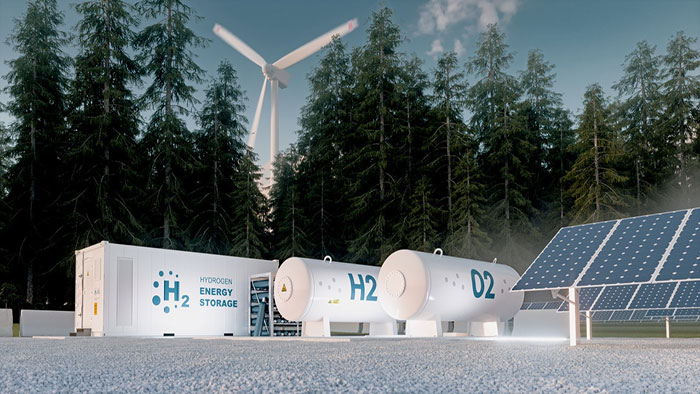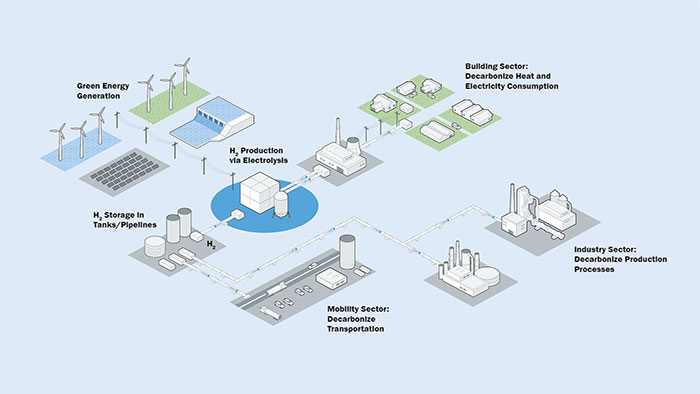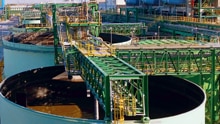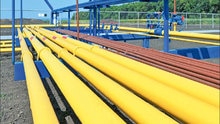L'électricité provenant de sources renouvelables est soumise à de fortes fluctuations et ne peut être stockée. La solution est un "contournement" : L'énergie verte peut être utilisée pour créer de l'hydrogène qui est transporté et utilisé via le réseau de gaz naturel. Cela présente des défis pour l'infrastructure du réseau de gaz et la technologie de mesure, comme l'a découvert SICK en tant que partenaire de la révolution énergétique.
Hydrogène à partir d'énergie verte - mesure fiable incluse
L'électricité produite à partir du vent, de l'eau, du soleil ou de la biomasse est essentielle pour la révolution énergétique, mais présente également certains problèmes : La production fluctue en fonction des conditions météorologiques et n'est pas calculable. Il n'est guère possible, à l'heure actuelle, de stocker l'électricité excédentaire des installations solaires et éoliennes. La technologie power-to-gas apporte une solution à ce problème. L'eau est divisée en oxygène et en hydrogène par hydrolyse. Idéalement, on utilise pour cela de l'électricité provenant de sources renouvelables, ce qui constitue une utilisation parfaite de cette électricité. L'hydrogène obtenu peut être utilisé de diverses manières. Outre son injection dans le réseau de gaz naturel, il est également possible, par exemple, de l'utiliser pour faire avancer des trains. Le concept de power-to-gas joue donc un rôle central dans l'action climatique, c'est pourquoi il fait actuellement l'objet de recherches approfondies.
L'hydrogène dans le réseau de gaz
Le FLOWSIC600-XT mesure l'hydrogène de manière fiable
L'équipe FLOWSIC du site de Dresde de SICK a la réponse : "En collaboration avec les experts de l'organisme de classification DNV SE, nous avons testé l'effet de l'hydrogène ajouté sur la technologie ultrasonique de nos appareils : Les appareils existants mesurent déjà le gaz naturel contenant de l'hydrogène de manière aussi fiable et stable que le gaz naturel sans hydrogène", explique Daniel Heinig, chef de produit stratégique. "L'appareil peut compenser toute incertitude de mesure - même dans les mélanges contenant jusqu'à 10 % d'hydrogène." Il est néanmoins possible que certaines applications deviennent limites en raison de l'ajout d'hydrogène. "Nous proposons donc à nos clients de vérifier leurs appareils FLOWSIC dans leur application spécifique et de leur donner une recommandation pour savoir si, et le cas échéant quelles conversions sont nécessaires pour les équiper pour une teneur en hydrogène plus élevée dans le gaz naturel à l'avenir", explique Daniel Heinig. SICK a même une solution pour une teneur en hydrogène plus élevée, jusqu'à 30 % : "Nous avons développé une nouvelle sonde à ultrasons qui peut déjà être installée en option dans la famille de produits FLOWSIC600-XT. Cette sonde convient à un large éventail d'applications et peut mesurer de manière très fiable et précise sur une plage encore plus large", déclare le développeur du produit, Thomas Hegewald. Ceci a également été confirmé par les résultats d'un test public indépendant réalisé par des partenaires industriels et en collaboration avec le DNV SE. Les appareils FLOWSIC déjà installés peuvent d'ailleurs être équipés ultérieurement de la nouvelle sonde.
Mesure du débit de gaz clé en main
Le développement de la sonde a représenté quelques défis pour l'équipe, car l'hydrogène, avec sa très faible densité, modifie le comportement de l'onde sonore dans le mélange gazeux : "Il en résulte une augmentation significative de la vitesse de propagation du son, ce qui rend la mesure acoustique plus difficile car des réflexions sonores peuvent apparaître dans le dispositif de mesure", explique Thomas Hegewald. "Nous avons résolu ce problème avec un faisceau sonore nettement plus étroit, qui permet de supprimer les réflexions latérales et garantit une mesure fiable même pour les petits diamètres nominaux. Les débitmètres de gaz FLOWSIC600-XT sont ainsi préparés à des teneurs élevées en hydrogène et constituent un investissement d'avenir pour nos clients."
Sur la base du FLOWSIC600-XT, SICK propose une solution de mesure de débit de gaz clé en main appelée FLOWSKID, et une solution de mesure de débit clé en main appelée FLOWRUN, où tous les aspects, de la gestion initiale du projet à l'installation et à l'entretien après la mise en service, ont été adaptés les uns aux autres.
En savoir plus
Hydrogène : Analyse polyvalente des gaz dans la production d'ammoniac
Optimisation de fonctionnement des centrales solaires - énergie solaire
Mettre les gaz pour la transition énergétique







